Vart är Svenska kyrkan på väg? - Gudstjänstfolket och liturgins tillhedjansspråk
Abstract
Towards the end of the last century, the bonds between church and state in Sweden existing since the time of the reformation were dissolved, and a new Church ordinance for the independent Swedish church came into use from i January 2000. The Swedish church there is defined as a Christian community leeding its history back to the earliest Christian congregations and their confession to Christ, and transmitting the apostolic faith. It has an evangelical-lutheran confession accepted 1593 including the ecumenical creeds from the early church and the Swedish Church ordinance from 1571. Also more recent documents accepted by the Swedish church are awarded a guiding function, and the importance of continuous theological reflection upon the faith in dialogue with other Christian traditions is emphasized.
The Swedish church sometimes is accused of not being firm enough in its doctrine. Personally, I judge it important always to bear in mind the conviction of the great Early Church theologians that God is ineffable. This conviction makes it necessary to accept that confessions and doctrines only have a tentative character. The Church ordinance underlines that they are not themselves the object of faith: they simply try to apply and explain faith. The Jewish thinker Martin Buber has warned us against speaking of God making God an object we have recourse to, rather than to God as Thou/ You, in a language of adoration. In the present essay, I have studied the character and development of adorative language in the Swedish church, concentrating on the liturgy of the eucharist.
My starting point is an ecumenical document accepted by the Swedish Church, the WCC-report Baptism, Eucharist and Ministry, 1982. It de scribes the meaning of the eucharist under five aspects: (1) »[...] as thanks giving to the Father [...] for everything accomplished in creation, redemption and sanctification». (2) »[...] as anamnesis or memorial f...| of the crucified and risen Christ, i.e. the living and effective sign of his sacrifice, accomplished once and for all on the cross and still operative on behalf of all humankind.» (3) »[...] as invocation of the Spirit [who] makes the crucified and risen Christ really present to us in the eucharistic meal, fulfilling the promise contained in the words of institution.» (4) »[...] as communion of the faithful [...] within the body of Christ [...] the Church [...]in search for appropriate relationships in social, economic and political life». (5) »[...] as meal of the Kingdom [...] at which the Church joyfully celebrates and anticipates the coming of the Kingdom in Christ».
Their repudiation of the medieval doctrine of the eucharistic sacrifice had led the Swedish reformers to delete the prayers surrounding the words of institution, instead placing these between the preface and the Sanctus. This gave a concentrated combination of aspects (1) and (2). (3) was missing (as in the medieval mass) and (5) not explicitly mentioned. The communion (4) was emphasized, but mainly as the individual believer’s meeting with Christ; the connection between the sacramental body of Christ and the church as his body lacked liturgical expression. No later Swedish liturgy went beyond this form of the liturgy till 1942, when the preface was anew combined with the Sanctus and an innovating prayer i.a. containing an invocation of the Spirit introduced as transition to the words of institution.
A wholly new liturgy for the eucharist was accepted in 1986. Here the language of adoration is really flourishing. The preface has 13 alternatives adapted to the ecclesiastical year. Instead of the one short 1942 prayer following the Sanctus there are now 8 alternative, much longer prayers surrounding the words of institution. The five aspects mentioned in the BEM report are all presented in diversified and enriching ways, even when approaching themes that in the light of traditional Lutheran theology appear a little delicate, e.g. the believers being included in the sacrifice of Christ forming one body with Him, or the Spirit and not exclusively the words of institution bringing about the sacramental presence of Christ.
Whereas the established Swedish church had a rather authoritarian form of government, and no deviations from the wordings of the prescribed liturgy were tolerated, the 2000 Church ordinance awards the local parish, »the primary unit within the church», a considerable degree of self-government. Not only can it choose freely among the many alternatives in the prescribed liturgy, it is also explicitly allowed, at certain occasions or during a longer period, to replace the official liturgy with alternative rites. Actually, a great number of newly created masses have appeared, in many different musical styles, mostly with extensive parts for the church choirs.
Seen in a longer historical perspective, the adorative creativity of the Swedish church during the latest decades is most striking. Since, according to our conviction, adorative language gives a more immediate and reliable access to the ineffable God than doctrinal language, a church showing an increasing openness towards that kind of language does not seem to be in danger of going seriously astray.
Downloads
Publicerad
Nummer
Sektion
Licens
© författarna, Laurentius Petri Sällskapet för svenskt gudstjänstliv samt Artos & Norma bokförlag. Det är tillåtet att kopiera och använda material ur Svenskt Gudstjänstliv för forskningsändamål om källan anges. För övriga ändamål kontakta respektive artikelförfattare samt förlaget. Särskilda restriktioner kan gälla för bildmaterial.


